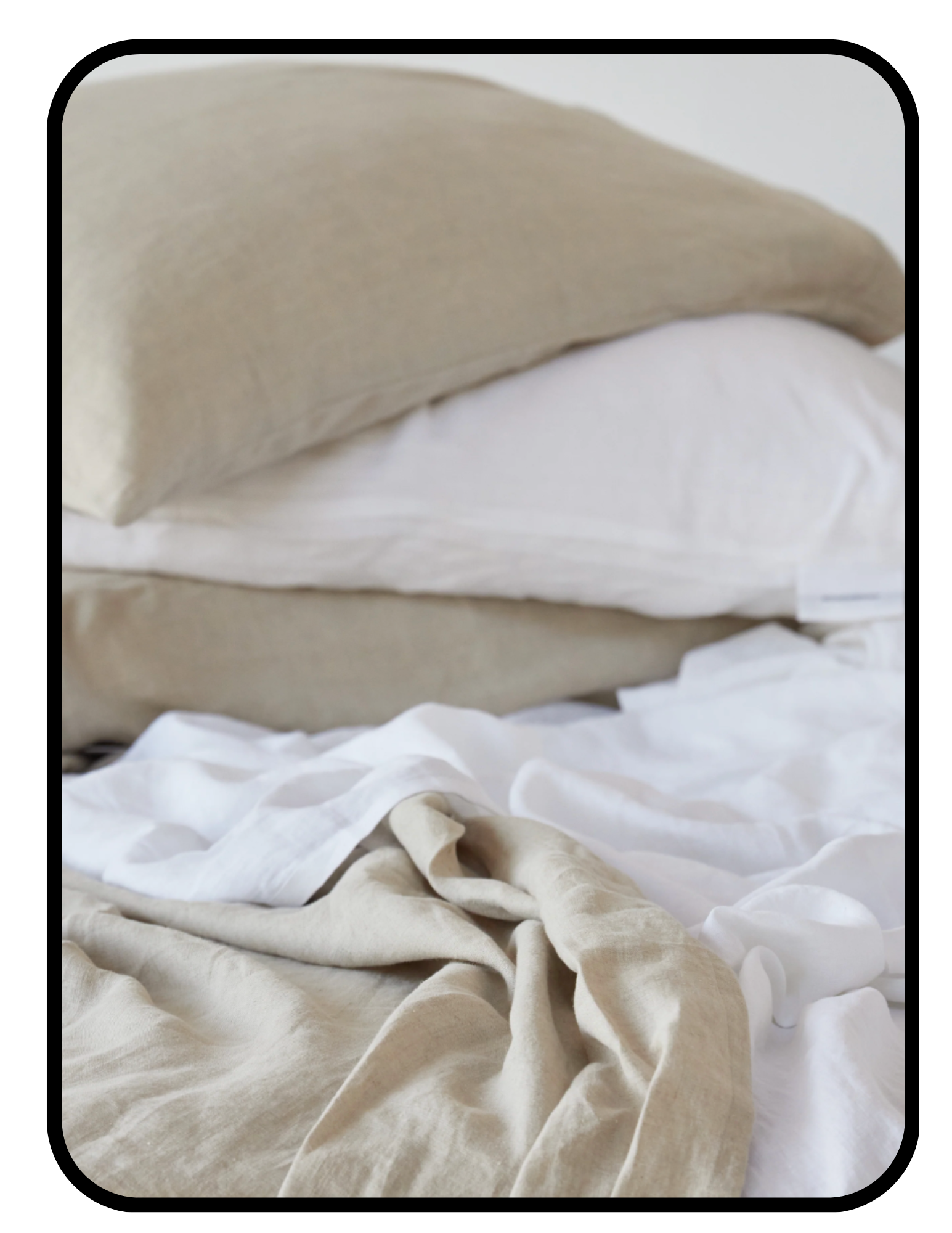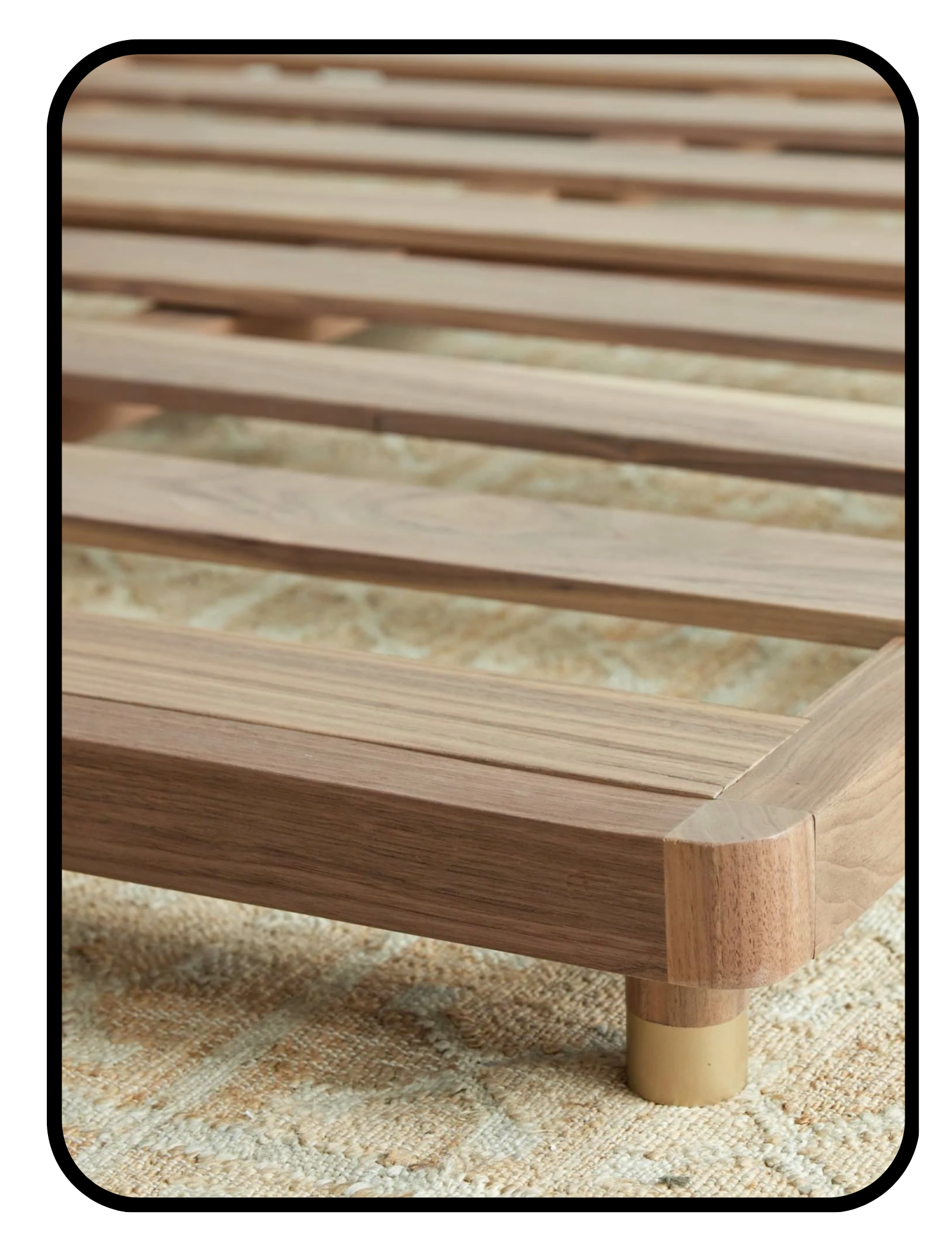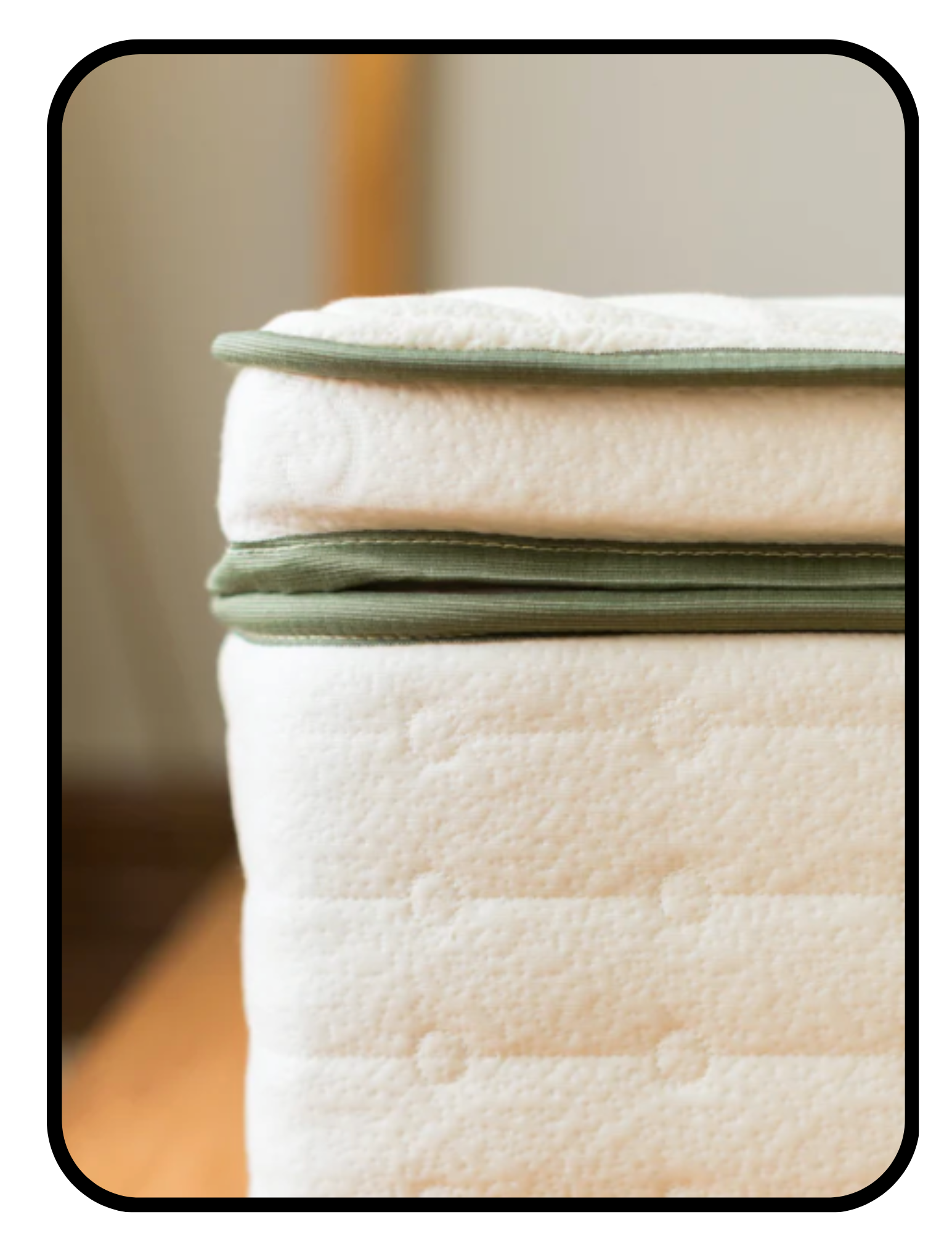Shop by Room ➜ Bedroom ➜ Bedding
Organic Bedding
The best organic sheets, pillow cases, and duvet covers. Click the rating symbols below each set of sheets for more information.
Organic Cotton Bedding
These organic cotton bedding sets, pillow cases, and duvet covers are dyed with herbs, and use a drawstring instead of elastic for the fitted sheets. I appreciate that they have GOTS certification, too, allowing a third party to verify their claims, then they go above and beyond to make their bedding even more organic. 10% off automatically applied through this link.
A super healthy and affordable bedding bundle deal. It includes a set of GOTS organic cotton sheets, as well as an organic waterproof mattress protector, and 2 natural shredded latex pillows that are a blend of GOLS certified Dunlop and C2C certified Talalay latex. Cool! Can also purchase the sheets on their own, of course.
Avocado carries several versions of organic cotton bedding, all of which are GOTS certified: sateen, percale, deep-pocket, and in several thread count options up to 1,000! Super soft, and consistently very highly rated. Ideal on their own, or convenient if you’re also ordering one of Avocado’s organic mattresses.
Very pretty, organic cotton bedding you can buy separates, or in bundles, in Twin, Full, Queen, King, or Cal King sizes. They always have trendy colors.
Naturepedic makes both breathable percale and sheeny sateen sheets with GOTS certification. Organic cotton sheets King, Queen, Full, Queen, Cal King, and Twin sizes.
Pact
The most affordable organic cotton sheets set and available in separates, as well. These super healthy sheets have GOTS certification, and come in three types: sateen, percale, and jersey, and in lots of pretty colors.
Linen Bedding
Avocado
These are some of the best organic bed linens because they go through the healthiest standard of fabric processing, and have GOTS certification to prove it. Linen fibers are hollow, releasing excess moisture, so you can sleep cool and dry. Ideal on their own, or convenient if you’re also ordering one of their organic mattresses.
100% organic bedding with GOTS certification. These sheets are an investment, but are some of the healthiest linen sheets available. Full size organic sheets, up to Queen, King, and Cal King. Pillowcases and duvet covers, too. Thermoregulating, these come in calming and earth-toned solid colors.
Most non-organic linen is not OEKO TEX certified, meaning they can contain harmful dyes and finishes. Importantly, Parachute linen sheets have OEKO TEX certification. You can buy separates, or in bundles, in Twin, Full, Queen, King, or Cal King sizes. Ideal on their own, or convenient if you’re also ordering one of Parachute’s organic mattresses.
Certainly a splurge, these natural linen sheets and pillowcases are rated best linen sheets by the Wirecutter every year because of their high quality. Healthwise, they do well too! They have OEKO TEX certification, ensuring they don’t use harmful dyes or finishing agents, and they are very, very cozy.
Some of the best linen bedding for their healthy OEKO TEX certification and their fun colorways. Mix and match their linen fitted sheets, flat sheets, duvet covers, bed throws, and pillowcases. I use some of these on my own bed and they’re the softest linen I’ve tried so far.
Non-Toxic TENCEL Bedding
Parachute has bedding made of 58% TENCEL and 42% linen, the perfect blend— linen is a natural fiber and has good moisture-wicking properties, and TENCEL makes the sheets softer and more breathable. Great for summer, for hot sleepers, and those easing into the world of linen. A win-win-win. Class 1 OEKO TEX certified, too. I have some for my bed for the summer months and they’re awesome.
SIJO makes 100% TENCEL bedding with OEKO TEX class 1 certification, ensuring they’re free of harmful chemicals. Pretty straightforward— they consistently get high ratings, and they’re healthier than average, too.
More Healthy Bedding
LilySilk is one of the very few GOTS certified organic silk sheet brands available. Silk is always an investment, and the GOTS certification ensures you get the healthiest version. Black silk sheets, pink silk sheets, silk sheet sets, pillowcases and more.
Hemp sheets still aren’t super popular, which is crazy, because they’re a lot like linen, but more durable and slightly less wrinkly. They start off a little more textured than linen, and soften really well over time. Avocado offers 100% GOTS certified organic hemp sheets that get consistently great reviews.
More Healthy Design For You
More About Organic Sheets
Click the bolded statements for links to research and more information.
What are the best organic sheets?
All of the options listed above are great choices for healthier sleep. To choose between linen, cotton, TENCEL, and other types of sheets, this is what I recommend:
Choose linen if you like a satisfying texture, prefer a cool sleep, can afford to spend a little more on sheets, and don’t mind wrinkles. They’re luxurious and highly breathable, and most people do well with them.
Choose linen-TENCEL blend sheets if you are easing into linen, are looking for a summer set, or tend to sleep warm.
Choose TENCEL sheets if you are a hot sleeper, or like a silky feel at a lower price than real silk.
Choose organic cotton sheets if you’re looking for a less expensive organic option, and usually don’t sweat too much at night.
Choose organic silk if you’re looking for super-smooth, super-breathable sheets, and are OK with splurging.
Choose organic hemp sheets if you like the texture of rough linen that softens over time, and appreciate durability.
What are the best cooling sheets for hot sleepers?
My theory is that hot sleepers are just using the wrong bedding! Linen, TENCEL, silk, or hemp are the best types of bed sheets for hot sleepers, and you may even find that you don’t “sleep hot” after all. Watch a 1 minute video explanation here.
What sheets are worst for hot sleepers?
Polyester, including microfiber, and some cotton sheets. Cotton absorbs moisture readily and doesn’t let it go, though if you love cotton, a Percale weave has more breathability than sateen. Polyester is a type of plastic, so it isn’t breathable, and can’t absorb any excess moisture. Heat and sweat are trapped under the sheets instead.
Are organic sheets worth it?
Yes, for two main reasons.
First, making fabric, including sheets, is a surprisingly chemically-intensive process. For natural sheets, if the fibers are grown conventionally, pesticides and fertilizers are used. Synthetic sheets (polyester, microfiber, etc) come from petroleum. Acids, scouring chemicals, and other processing agents used to wash fibers. Fiber-strengthening chemicals are aded to turn the fibers into sheets of fabric. Detergents, solvents, bleaches, acids, and enzymes are used to remove chemicals from previous steps, make the fabrics lighter, or prepare them to accept dyes in the next step. Pigments, binders, plasticizers, PVC, and other polymers (plastics) are used in this step, to make the dyes stick to the surface of the fabric. Finally, chemical treatments are added to make the fabric perform a certain way. Formaldehyde resins offer wrinkle-resistance, other resins work for anti-pilling, PFAS for stain-resistance, polyglycols for anti-pilling, acrylates or PVC with plasticizers for protective coatings, and flame retardants for fire resistance. Read more about this process and fabric in general in my Fabric Guide.
Second, organic fibers support better sleep. Polyester and microfiber are plastic, and trap heat and moisture, leading to frequent waking and unrestful sleep.
What is linen? Why is it special?
Linen is a natural fiber that comes from the flax plant and is woven into fabric. Different parts of the flax plant are used to make linseed oil, linoleum, and flax seeds. It’s been used by humans for at least 30,000 (!) years. The fabric is thermoregulating, meaning they keep you warm when it’s cold, and they cool you off when you’re warm. They do this because they’re pretty dense, retaining heat, but they have a hollow core that draws moisture and excess heat away from your body and into dry-er air on the other side of your sheets.
Is linen organic?
There are only a handful of GOTS certified organic linen crops because it’s naturally pretty healthy. Many brands will still go for OEKO TEX certification to show that they do not add harmful dyes or other finishes to the final product. Compared to cotton, linen is rare and far less chemically intensive— it takes many years to grow a crop, they only grow in cool climates, and linen relies on hand-processing than chemicals.
What is Tencel vs. Rayon vs. Viscose?
All three are semi-synthetic, plant-based polymer fabrics. Read about them in depth in my Fabric Guide. For all three, cellulose is mixed with a solvent to make it liquid, then it’s re-formed on a machine into fibers. Viscose’s cellulose comes from wood pulp. Rayon’s cellulose comes from other plants— eucalyptus, bamboo, soy, or cotton. Tencel is a brand name rayon that comes from eucalyptus. All three require less pesticides and water than conventional cotton production and is certainly better for people and the planet than a completely petroleum-based fabric like polyester or vinyl, but still isn’t as healthy as a truly natural fabric from a material perspective. However, it is very breathable and has good moisture-wicking properties, so can support healthy sleep, which is healthy in itself. These products generally earn an OK! rating from me, and many are OEKO TEX certified. I use some OEKO TEX Tencel products in my own home (like pillowcases when my skin is dry, for example).
What makes wrinkle-free sheets wrinkle-free?
Unfortunately, formaldehyde is commonly added as a finish to make sheets wrinkle free. It is a well-established carcinogen, and can also cause allergic reactions on the skin. This is an especially common practice for cotton sheets, so choosing organic GOTS certified or OEKO TEX certified sheets will protect you against this.
Shop by Room ➜ Bedroom ➜ Bedding





























